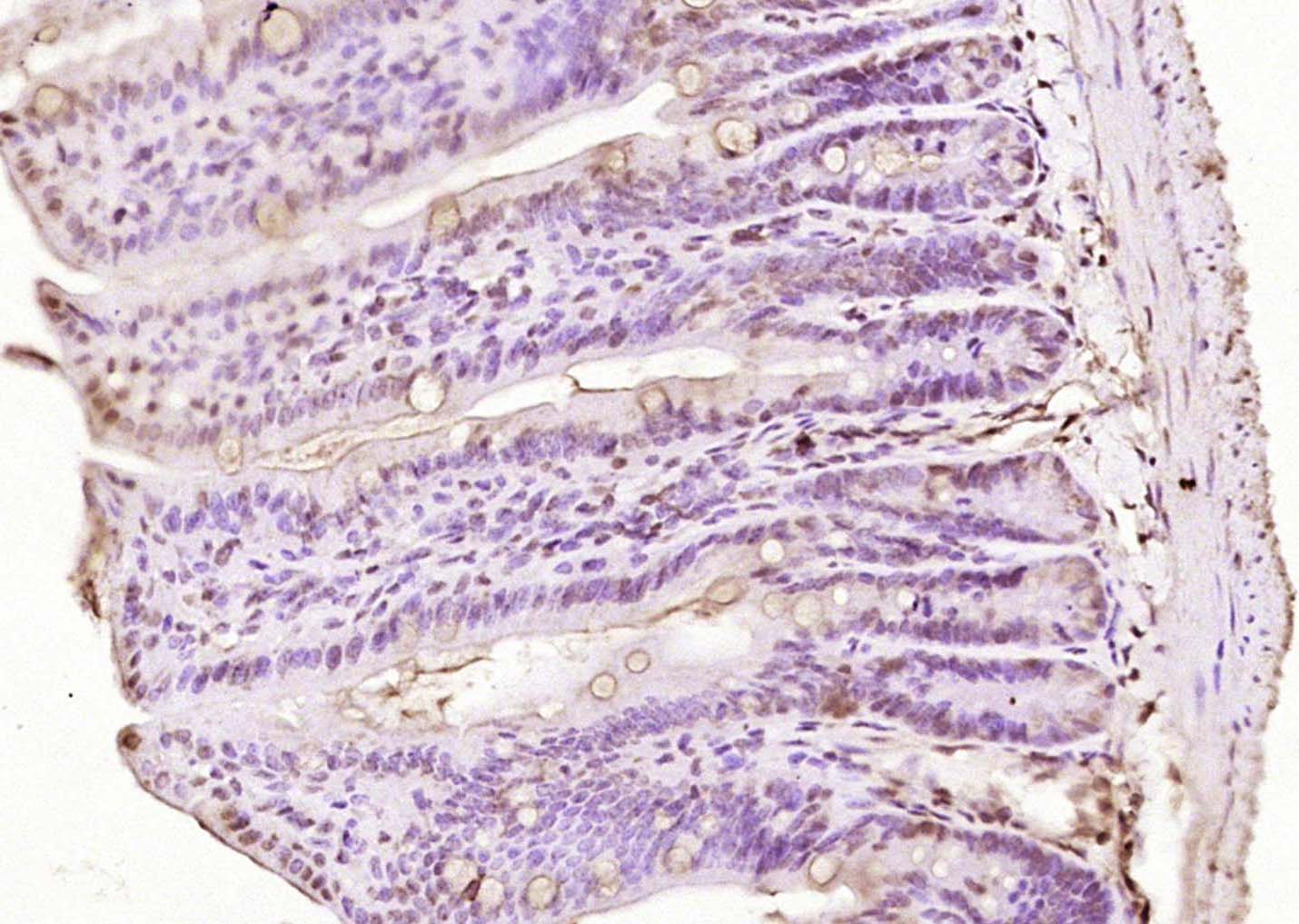
Rabbit Anti-phospho-HDAC2 (Ser394)antibody
HDAC2 (Phospho-Ser394); HDAC2 (phospho S394); HDAC2 (phospho Ser394); p-HDAC2 (Ser394); HDAC2_HUMAN; Histone deacetylase 2; EC:3.5.1.98; HD2; Protein deacylase HDAC2;
View History [Clear]
Details
Product Name phospho-HDAC2 (Ser394) Chinese Name 磷酸化组蛋白去乙酰化酶2抗体 Alias HDAC2 (Phospho-Ser394); HDAC2 (phospho S394); HDAC2 (phospho Ser394); p-HDAC2 (Ser394); HDAC2_HUMAN; Histone deacetylase 2; EC:3.5.1.98; HD2; Protein deacylase HDAC2; literatures Product Type Phosphorylated anti Research Area Tumour immunology Signal transduction transcriptional regulatory factor Epigenetics Immunogen Species Rabbit Clonality Polyclonal React Species Mouse, (predicted: Human, Rat, Chicken, Dog, Pig, Cow, Horse, ) Applications ELISA=1:5000-10000 IHC-P=1:100-500 IHC-F=1:100-500 ICC=1:100-500 IF=1:100-500 (Paraffin sections need antigen repair)
not yet tested in other applications.
optimal dilutions/concentrations should be determined by the end user.Theoretical molecular weight 55kDa Cellular localization The nucleus Form Liquid Concentration 1mg/ml immunogen KLH conjugated Synthesised phosphopeptide derived from human HDAC2 around the phosphorylation site of Ser394: ED(p-S)GD Lsotype IgG Purification affinity purified by Protein A Buffer Solution 0.01M TBS(pH7.4) with 1% BSA, 0.03% Proclin300 and 50% Glycerol. Storage Shipped at 4℃. Store at -20 °C for one year. Avoid repeated freeze/thaw cycles. Attention This product as supplied is intended for research use only, not for use in human, therapeutic or diagnostic applications. PubMed PubMed Product Detail This gene product belongs to the histone deacetylase family. Histone deacetylases act via the formation of large multiprotein complexes, and are responsible for the deacetylation of lysine residues at the N-terminal regions of core histones (H2A, H2B, H3 and H4). This protein forms transcriptional repressor complexes by associating with many different proteins, including YY1, a mammalian zinc-finger transcription factor. Thus, it plays an important role in transcriptional regulation, cell cycle progression and developmental events. Alternative splicing results in multiple transcript variants. [provided by RefSeq, Apr 2010].
Function:
Responsible for the deacetylation of lysine residues on the N-terminal part of the core histones (H2A, H2B, H3 and H4). Histone deacetylation gives a tag for epigenetic repression and plays an important role in transcriptional regulation, cell cycle progression and developmental events. Histone deacetylases act via the formation of large multiprotein complexes. Forms transcriptional repressor complexes by associating with MAD, SIN3, YY1 and N-COR. Interacts in the late S-phase of DNA-replication with DNMT1 in the other transcriptional repressor complex composed of DNMT1, DMAP1, PCNA, CAF1. Deacetylates TSHZ3 and regulates its transcriptional repressor activity. Component of a RCOR/GFI/KDM1A/HDAC complex that suppresses, via histone deacetylase (HDAC) recruitment, a number of genes implicated in multilineage blood cell development.
Subunit:
Component of a RCOR/GFI/KDM1A/HDAC complex. Interacts directly with GFI1 and GFI1B. Interacts with SNW1, HDAC7, PRDM6, SAP30, SETDB1 and SUV39H1. Interacts with the H2AFY (via the non-histone region) (By similarity). Part of the core histone deacetylase (HDAC) complex composed of HDAC1, HDAC2, RBBP4 and RBBP7. The core complex associates with MTA2, MBD3, MTA1L1, CHD3 and CHD4 to form the nucleosome remodeling and histone deacetylation (NuRD) complex, or with SIN3, SAP18 and SAP30 to form the SIN3 HDAC complex. Component of a BHC histone deacetylase complex that contains HDAC1, HDAC2, HMG20B, KDM1A, RCOR1 and PHF21A. The BHC complex may also contain ZMYM2, ZNF217, ZMYM3, GSE1 and GTF2I. Part of a complex containing the core histones H2A, H2B, H3 and H4, DEK and unphosphorylated DAXX. Part of a complex containing ATR and CHD4. Forms a heterologous complex at least with YY1. Interacts with ATR, CBFA2T3, DNMT1, MINT, HDAC10, HCFC1, NRIP1, KDM4A and PELP1. Component of a mSin3A corepressor complex that contains SIN3A, SAP130, SUDS3, ARID4B, HDAC1 and HDAC2. Interacts with CHFR and SAP30L. Interacts (CK2 phosphorylated form) with SP3. Interacts with TSHZ3 (via its N-terminus). Interacts with APEX1; the interaction is not dependent on the acetylated status of APEX1. Part of a complex composed of TRIM28, HDAC1, HDAC2 and EHMT2.
Subcellular Location:
Nucleus.
Tissue Specificity:
Widely expressed; lower levels in brain and lung.
Post-translational modifications:
S-nitrosylated by GAPDH. In neurons, S-Nitrosylation at Cys-262 and Cys-274 does not affect the enzyme activity but abolishes chromatin-binding, leading to increases acetylation of histones and activate genes that are associated with neuronal development. In embryonic cortical neurons, S-Nitrosylation regulates dendritic growth and branching.
Similarity:
Belongs to the histone deacetylase family. HD type 1 subfamily.
SWISS:
Q92769
Gene ID:
3066
Database links:Entrez Gene: 3066 Human
Entrez Gene: 15182 Mouse
SwissProt: Q92769 Human
SwissProt: P70288 Mouse
Product Picture
Bought notes(bought amounts latest0)
No one bought this product
User Comment(Total0User Comment Num)
- No comment



 +86 571 56623320
+86 571 56623320
 +86 18668110335
+86 18668110335

